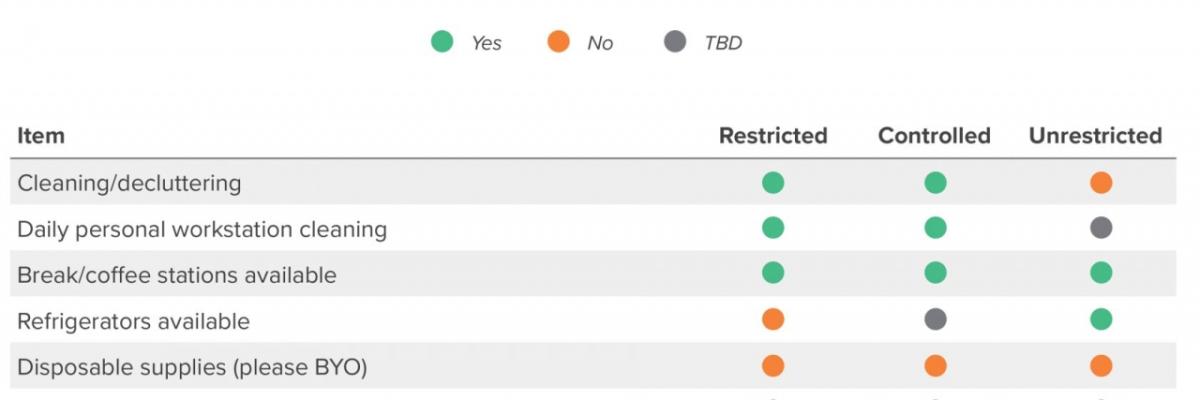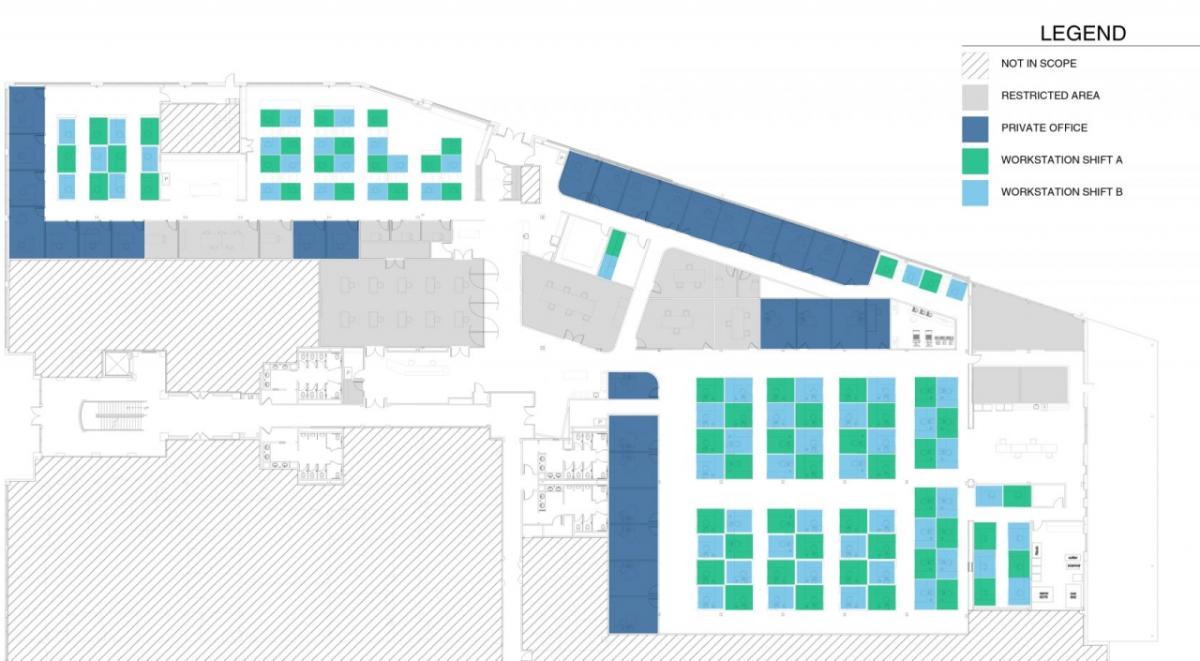COVID-19: 7 Steps to Plan for Re-Entering the Workplace
The COVID-19 pandemic has presented new challenges and created questions about what life in the office will look like going forward
Many of our clients are asking the same questions that we are internally: How do we effectively plan, communicate and execute new guidelines that follow health and government guidelines for all our offices and employees when we are all experiencing different stages of this pandemic?
We have decided to share the beginning steps of CRB’s approach to re-entering the workplace to help those that are looking for guidance during this time. Our plan is outlined in a three-phased approach to cautiously return to the workplace.
- The Restricted Phase is the most stringent as we re-learn the safe use of offices with physical distancing and new standards for cleanliness. Among other guidelines, conferencing rooms will not be available, no guests will be allowed, and masks will be required. The good news: this is expected to be the shortest phase.
- The Controlled Phase brings back some office amenities and we potentially re-work seating plans to bring teams together, flexibly and safely. In time, clients may be allowed to visit the offices again. The duration of this phase is uncertain, and we are planning for it to extend at least through the end of 2020.
- The Unrestricted Phase means that things are mostly getting back to normal. To enter this phase, it seems that guidance from the global healthcare community would be a prerequisite.
This guide is primarily focused on preparations for the first phase of re-entry, which we have identified as the “Restricted Phase.” Below you will find a step-by-step approach that serves as a guide to inform local leaders as they prepare for re-entering the workplace.
Step 1: Establish your team
Establish a re-entry task force. When establishing your team, considering creating a multi-disciplinary task force. Members could include architects, human resources, marketing, safety and management. This task force is responsible for developing the specific approach to re-entering the workplace and communicating it across the company.
Tip: Create a roles and responsibilities matrix. This matrix should identify members of your “workplace re-entry team” and outline individual responsibilities.
Step 2: Check governmental guidance
Adhere to applicable governmental guidelines. These can be found at the federal, state, county, city, and metro level, and vary by location. These guidelines change frequently and are expected to do so as the coronavirus pandemic continues.
Tip: Assign an internal resource to keep an updated database with governmental guidelines for re- opening. When you are ready to begin preparing your office to enter the workplace, schedule a meeting to review the most current updates.
Step 3: Supervisor training
A top priority during this pandemic is making employees feel comfortable as we begin to re-enter the workplace. This situation creates different personal challenges for employees. Effectively returning to the workplace requires strong leadership, collaboration and engagement from everyone. Use your in-house Human Resources Team to provide guidance and training for supervisors to follow as they support employees during the transition back to the office.
Tip: Create a roadmap with reminders, checklists and helpful tips for supervisors to print and keep at their desks.
Step 4: Set up your health station
Consider re-tooling your office reception areas as health stations. This is where employees check in and out, complete health checks, learn about using the office safely, and receive supplies. The use of a health station is a necessary upgrade to ensure offices can maintain safety controls and contact tracing.
Tip: Especially during their first days back, re-entering the office can be stressful for some employees. Having a clear process can help them build up their own comfort and sense of confidence.
Step 5: Plan your space
To use the existing layouts and furniture, occupancy reductions, circulation paths and assigned seating can be modified to accommodate physical distancing recommendations.
- Occupancy Reductions: Gather information about current office capacities and reduce occupancy based on guidelines. Create capacity graphs to allow a quick side-by-side view of the current office capacity, in comparison to updated reduced occupancy per local guidelines.
- Identify Circulation: Establish the direction of foot traffic and identify two-way vs. one-way circulation, mark circulation in a clockwise direction where possible.
- Assign Workstations: Apply a checkerboard pattern to workstations and coordinate with supervisors to implement a shiftwork pattern to ensure physical distancing while employees are seated at their stations.
- Apply Signage: Create signage and decals to indicate one-way circulation path, standing points for physical distancing and desk decals to reflect shiftwork.
Tip: Engage a consultant with space planners or architects on staff to help adjust current layouts to fit these new guidelines.
Step 6: Clean your space
With what we know about this virus, cleanliness needs to be top of mind for organizations during this process. While most organizations have cleaning services in place, we all now have an individual responsibility for keeping the office and community amenities clean.
- Determine what surfaces are cleaned and how often
- Establish a list of necessary cleaning supplies to meet the required level of cleaning in each office.
- Setup cleaning substations
- Maintain a cleaning log that is updated daily
- Declutter by evaluating what items can be moved or removed completely to reduce frequent handling or contact.
- Establish shared appliance allowances for this first phase and how to properly sanitize after each use.
Tip: Maintain a cleaning log daily to ensure all cleaning requirements are met.
Step 7: Coordinate with landlord
Many offices are located within a multi-tenant commercial office building. These professional environments include shared elevators and stairwells, gyms and cafés, other tenants, and building systems – all of which employees encounter through the course of a normal working day. Landlords and their property management teams are critical partners in maintaining safe, clean workplaces.
Tip: Issue a questionnaire to gather key information about each landlord’s response to the coronavirus pandemic. The questionnaire can cover topics such as: tenants and guests, people circulation, janitorial and maintenance, building systems, and emergency preparedness.
As plans commence for the return to the office, we hope by sharing our process that it will support others with business continuity and ensuring the safety of workers everywhere. General guidance abounds, but every office space is different. Get started by working through these steps to have solutions in place for your re-opening day.
Questions? Contact John Schwaller, john.schwaller@crbusa.com.
CRB’s Re-Entry Task Force (contributors): John Schwaller, Andi Feeley, Jay Marshall, Vince Corden, Steve Pianalto, Jesse Taborsky, Audra Augustin, Danielle David, Rebekah Hunter, Shoshana Marske, Pam Rezzelle, Patti St. Vincent, Marilou Wilson, Robert Brady, Karla Chiarelli, Jamie Nelson, Debra Reed, Tracy Stanfield, Viktoriya Lupareva, Lauren Candelora, Kelsey Monahan, Kevin Kuzma, Nicole Lane, Madi Olberding, Lindsay Kenney, David Keith, Chelsea Stramel





